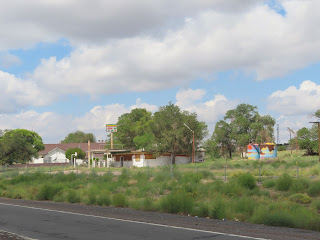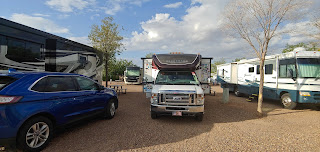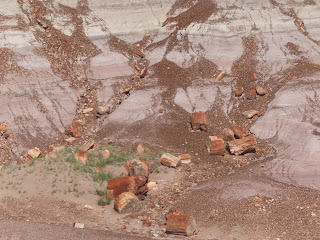Today we caravanned from Gallup NM and crossed into Arizona for our one night stay in Holbrook.
Yellowhorse located in Arizona at the border of Arizona and New Mexico at Interstate 40. The Yellowhorse Family actively manages the Navajo-Owned trading post on the Navajo reservation. It all started in the 1950's from a roadside stand that the Yellowhorse family started selling Navajo rugs and petrified wood to the passer-by vacationers. Traveling the route 66 was an adventure in itself, and stops were far in between. So the need to stop and stretch along with the gnawing curiosity to meet with the Navajo family was the ingredient for success and great memories for everyone. In the 60's, Juan and Frank Yellowhorse, tidy up some at the newly constructed trading post, not far from the rug stand. The addition of gas pumps, and new signs along the Route 66, were constructed.
Chief Yellowhorse Trading Post, in addition to being one of the oldest Navajo businesses in the region, also was known for painting the dividing line between New Mexico and Arizona right in the middle of the store and the red cliffs that overlooked it. We could not find the dividing line, but we did find unique stuffed animals on the cliff!
We crossed from the 47th state, New Mexico, to the 48th state, Arizona. However, after much effort, on January 6, 1912 New Mexico became the 47th state and on February 14, 1912 Arizona became the 48th state in the Union.
In Arizona on Route 66, is the small town of Houck. This community of a little more than 1,000 people is called Ma’ii Tó by the Navajo, meaning Coyote Water, which is the name of a local spring. Houck was founded by an express rider carrying the mail between Prescott, Arizona and Fort Wingate, New Mexico. The first route through the area was a wagon road on the south side of the Puerco River that connected Fort Wingate, New Mexico with Fort Whipple, Arizona. This road became the “Overland Stage Road” and was in regular use by the 1870s.
As you drive down any Arizona highway and you’re bound to come across abandoned sites. The dusty foundations of ghost towns and once prominent businesses are now decaying under the hot sun. Of the many trading posts to be found along Route 66, it’s surprising to learn that less is known about one of the most recent than of those that ceased to exist decades ago, such as the Rattlesnake Trading Post and Bowlins in Bluewater, New Mexico. But, just across the border into Arizona, Fort Courage, which only finally closed a couple of years ago, is quickly falling into disrepair and obscurity.
Fort Courage was a booming attraction along Route 66! Built in the 1970’s to cash in on some of that sweet F Troop money, Fort Courage is a replica fort built to resemble the one from the classic show. F Troop was a television series that ran from 1965-67, set in the fictional Fort Courage, an Army outpost and neighboring town out in the wilderness of the 1860s. The bumbling troop got into all manner of pickles and hijinks during its two seasons, before finally going off the air in 1967. However, the show’s legacy lived on at the roadside attraction Fort Courage, well kind of… The site of a trading post since 1924 when Joseph Grubbs opened the White Mound Trading Post, the tiny town of Houck – originally known as Houck’s Tank after the man who founded it and, yes, his water tank – served first one alignment of the Old Trails Highway and then Route 66. When Route 66 was rerouted in 1933, Grubbs moved his store to where Fort Courage now stands. The White Mound, which also acted as Houck’s post office, finally closed in 1948.
The replica fort, while not officially affiliated with the show, did not let this potential legal hurdle stop them, selling official merchandise and proudly displaying actual F Troop props. Because there was only so long that F Troop impersonating could be considered even vaguely financially viable, there was also a general store that sold groceries and Native American arts and crafts. History has not been kind to Fort Courage. Opened less than fifty years ago, there seems to be no record of even when it actually opened, let alone any details of what is likely to become of it. Faded billboards along the interstate still exhort the traveler to stop, but there’s no longer any genial welcome at Fort Courage. Its single legacy seems to be in the late night reruns of F Troop when viewers of a certain age might pause and think, ‘Didn’t we stop on the film set in Arizona when I was a kid…?’
Also on the trading post property were an Armco gas station and a pancake house, both now abandoned. Next to the trading post is the abandoned Pancake House which was originally built as a restaurant by Van de Kamp’s Holland Dutch Bakery of Los Angeles. The company had a chain of windmill-styled bakeries around LA and plans to extend across the country with a distinctive windmill building design. The concrete building had sixteen sides to give the appearance of being round, while the roof would have once supported a giant windmill, although no photographs appear to exist of this. Van de Kamp intended to build 40 of these quirky buildings by 1970, but never came close to that figure. The Houck Pancake House is one of only two of the designs to survive; the other is in Arcadia, California, where the building is now a Denny’s (and that company had wanted to demolish it in 1999 before a local outcry forced a change of mind). The Pancake House also housed a coffee shop and, if you believe the signs, a Taco Bell. Personally, I would treat that with a pinch of salt and a Fort Courage type of disregard for legalities. It’s far more likely that it was an Ortega’s Tacos, named after Armand Ortega who ran the trading post for some years.
We knew we were getting closer to the Painted Desert and Petrified Forest when we started seeing the shops with all the dinosaurs!
We are staying at the Holbrook/Petrified Forest KOA. We arrived early, got set up and arranged rides back to the Painted Desert and Petrified Forest.
Our first stop was The Painted Desert. It is located on the eastern side of the Copper State. The Painted Desert is just unbelievable. It formed over millions of years by natural processes like wind and water erosion. It's a true badlands desert in Arizona, and part of it even overlaps with the strange and beautiful Petrified National Forest, which we will also visit. The Navajo and Hopi people have lived in this region for hundreds of years, but it was Spanish Colonialists who gave it the name we know it by today – El Desierto Pintado (Painted Desert).
When you enter into the Painted Desert, art comes to life. A region encompassing more than 93,500 acres, this vast landscape features rocks in every hue – from deep lavenders and rich grays to reds, oranges, and pinks. It’s like you’ve been transported into a painting. A natural canvas millions of years in the making, no one event shaped the Painted Desert. Instead, the area is evidence of Earth’s volatility. Home to some of the nation’s most memorable formations and features, volcanic eruptions, earthquakes, floods, and sunlight, all combined to create the Painted Desert. Deposits of clay and sandstone, stacked in elegant layers, reflects the setting Arizona sun in an altering display of colorful radiance. A remarkable sight that helps make Northern Arizona so unique and picturesque.
Our first stop was at Tawa Point, an established overlook close to the north entrance. It afforded us our first real view of The Painted Desert. As we pulled away, we had Charlie stop again and a ranger asked him to pull all the way off the road. Sorry, Sweetheart! Mary and I found a trail and we started walking it. We figured it would loop us around back to the parking area. Wrong … we kept walking and ended up at our second stop.
The Painted Desert Inn is a National Historic Landmark that began as a petrified wood and native stone house built by homesteader Herbert David Lore prior to 1920. The “Stone Tree House” operated as a tourist attraction, offering food, lodging, and tours for nearly twelve years. The National Park Service purchased the property in 1936. Architect Lyle Bennett redesigned the inn in the Pueblo Revival Style, and Civilian Conservation Corp (CCC) workers brought the design to life.
In the late 1940s, the Painted Desert Inn became a Harvey House when the Fred Harvey Company assumed management. Famed southwest architect Mary Colter played a role in the next phase of renovations and repair. Three of six rooms at the inn served as guestrooms for travelers until 1950 when they all became quarters for Harvey Girls. These young ladies with strong moral character and work ethic served customers and ultimately became American legends.
The Painted Desert Inn is a historic Inn turned museum offers exhibits about the CCC, Fred Harvey Company and more. In its almost 100 years overlooking the Painted Desert, the inn has undergone many changes. The national historic landmark functions only as a museum now, with no overnight accommodation and food service. Displays inside highlight the building's history, Route 66, and the Civilian Conservation Corps. There are also restored murals by Hopi artist Fred Kabotie. Sadly, COVID stopped us from entering and seeing the history!
Every time we stopped, we enjoyed the Painted Desert Overlooks. Each overlook is so very different from the overlook before. A different artist and a different canvas. Breathtaking!
A 1932 Studebaker sits where famed Route 66 once cut through the park. A rusted-out 1932 Studebaker is perhaps the most-photographed manmade feature within the park. The remains of this classic car is part of an outdoor exhibit marking the alignment of Route 66.
The Mother Road was open through Petrified Forest National Park from 1926 through 1958, making it the only national park to hold this distinction. A row of antique telephone poles traces the original route through the park, and a vintage car-themed concrete bench monument memorializes the historic road.
Interstate 40, the modern highway that replaced the Mother Road, parallels the original route in the distance.
The next section of road passes through The Tepees. Named for their shapes, this region of the Painted Desert has a lovely palette dominated by blues, rust, and white. If you don’t like to hike, this stretch of road gives you a close-up view of the multi-layered rock formations.
At Newspaper Rock, you can look down from the overlook to see over 650 petroglyphs, some as old as 2000 years. Hence the name, newspaper ……
You must turn off the main road and drive a 3.5 mile loop to experience the Blue Mesa. The prominent colors in this area of the park are blues, purples, grays, and browns. In the Painted Desert, light is everything. Colors seem to move and change as the sun traverses the sky. I think the shades and hues of the Blue Mesa are my favorite, with layers and textures not unlike a Missoni design. I wish we had time to walk the 1-mile loop around them. I would have loved to have been up close to the bottom of these beauties!
At our next pullover on the loop, I was so engrossed in the rock formations that I did not even notice this was a transition zone. We are moving from The Painted Desert into the Petrified Forest … look at the Petrified wood hiding in plain sight!
I won't teach a lesson on the origins of the Petrified Forest nor the process of petrification. I think it is important to know, however, that the Petrified Forest had its beginnings in the Late Triassic Period when all of Earth's continents were connected in a super landmass called Pangaea. Some scientists believe the region that is now Arizona was located along the same parallels as Costa Rica and had a tropical climate. I was surprised to learn that petrified wood can be found in all 50 states and many locations around the world. There is even a petrified forest in Mississippi. Who knew?
What sets Arizona's Petrified Forest apart is that it contains the largest concentration of petrified wood on earth. Petrified logs are increasingly becoming the dominant feature, and the multi-colored desert is now becoming the backdrop. The Jasper Forest – panoramic view of high concentrations of petrified wood. The Jasper Forest overlook is a great location for a sweeping view, with petrified logs as far as the eye can see.
The Crystal Forest offers many petrified logs glimmering with quartz crystals along a paved loop trail. Crystal Forest is the perfect place to see many intact petrified trees and logs that appear to have been cleanly cut with chainsaws. Appearances can be deceiving.
Quartz crystals inside the logs produce clean fractures when pressured by forces of nature. In the morning or late afternoon puts the sun at an angle to best experience the sparkling colorful crystals.
We enjoyed dinner at
It was a restful evening at the campground. Another great day on our #Route66RVcaravan with #yankeeRVtours
#TwoLaneAdventures





































We really enjoyed the Painted Desert. The colorful hues are just spectacular!
ReplyDelete